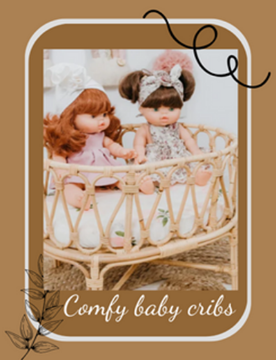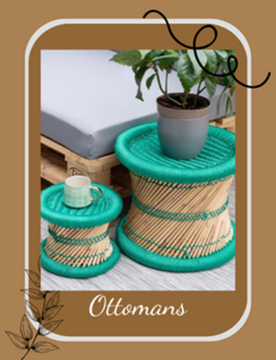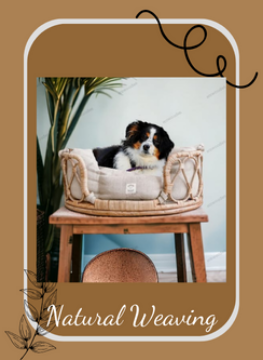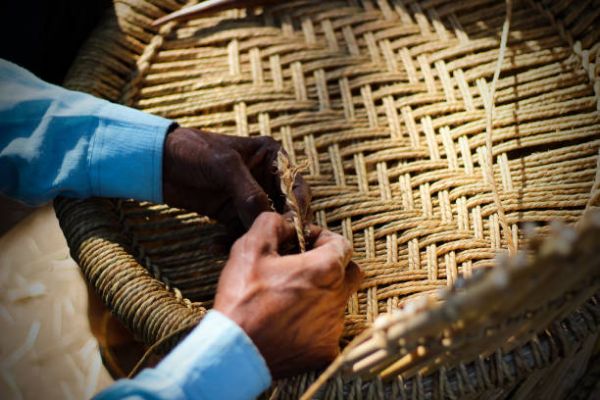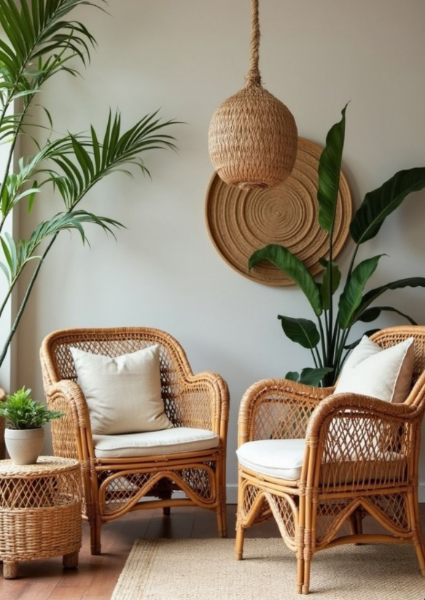In a world increasingly focused on sustainability and natural materials, bamboo combs have emerged as a perfect blend of practicality, eco-friendliness, and timeless style. These elegant hair care tools complement the growing trend of bamboo and rattan furniture in homes worldwide, offering a cohesive approach to natural living that extends from your living room to your personal care routine.
Why Bamboo Combs Are Having a Moment?
The humble comb might seem like an afterthought in your daily routine, but this essential tool touches your hair—and by extension, influences your appearance—every day. Traditional plastic combs have dominated the market for decades, but as consumers become more environmentally conscious, bamboo combs are gaining popularity for good reason.
Bamboo combs represent more than just a trend—they're part of a larger movement toward sustainable living that includes bamboo furniture, rattan decor, and natural fiber home goods. With their smooth finish, gentle touch on the scalp, and minimal environmental impact, bamboo combs offer a simple yet meaningful way to incorporate sustainable practices into your daily life.
Whether displayed on a bamboo vanity in your bedroom, stored in a rattan basket in your bathroom, or tucked into your sustainable travel kit, bamboo combs complement natural home aesthetics while providing superior functionality compared to their plastic counterparts. This seamless integration makes them the perfect accessory for homes already embracing the warmth and organic beauty of bamboo and rattan furniture.
In this comprehensive guide, we'll explore everything you need to know about bamboo combs—from their historical significance and environmental benefits to practical care tips and styling recommendations. We'll also discuss how these natural grooming tools complement other bamboo and rattan products in creating a cohesive, eco-friendly lifestyle.
The Rich History of Bamboo Combs
Ancient Origins and Cultural Significance
Long before plastic became ubiquitous, people across cultures used natural materials for their daily needs—including hair care. Bamboo combs have a particularly rich history:
- Asian Heritage: In China, Japan, and throughout Southeast Asia, bamboo combs date back thousands of years. These regions, where bamboo grows abundantly, developed sophisticated techniques for crafting durable, smooth combs that became essential grooming tools.
- Status Symbols: In many ancient societies, intricately carved bamboo combs were more than utilitarian objects—they served as status symbols and were often presented as meaningful gifts, particularly in wedding ceremonies.
- Spiritual Significance: In some traditions, bamboo combs were believed to carry spiritual properties. The natural material was thought to channel positive energy, while the act of combing was associated with clearing away negative influences.
- Medicinal Applications: Traditional medicine systems, particularly in China and India, incorporated bamboo combs as tools for stimulating the scalp, improving circulation, and promoting hair health—applications that modern science has begun to validate.
This deep historical connection explains why bamboo combs feel inherently meaningful compared to mass-produced plastic alternatives. They represent a return to traditional wisdom and time-tested natural solutions.
Evolution Through the Centuries
While maintaining their essential natural characteristics, bamboo combs have evolved over time:
- Craftsmanship Refinement: Ancient artisans developed techniques to split, shape, and polish bamboo into increasingly refined combs, creating smoother teeth and more comfortable handles.
- Design Variations: Different cultures developed distinctive bamboo comb styles—from wide-toothed detangling combs to fine-toothed styling implements—each serving specific hair care needs.
- Decorative Techniques: As bamboo combs became valued possessions, artisans began adding decorative elements through carving, painting, and inlay work with materials like shell or bone.
- Modern Adaptations: Today's bamboo combs combine traditional craftsmanship with modern design sensibilities, creating tools that honor historical practices while meeting contemporary styling needs.
This evolution parallels the development of bamboo and rattan furniture, which has similarly transitioned from purely functional to aesthetically sophisticated while maintaining connections to traditional craftsmanship.
Environmental Benefits of Choosing Bamboo Combs
Bamboo: A Truly Sustainable Resource
The environmental advantages of bamboo combs begin with the remarkable properties of bamboo itself:
- Rapid Growth: Bamboo is one of the fastest-growing plants on Earth, with some species growing up to 91 cm (36 inches) in a single day. This means bamboo can be harvested every 3-5 years, compared to hardwood trees that take decades to mature.
- Self-Regeneration: When bamboo is harvested, the root system remains intact, allowing new shoots to grow without replanting. This makes bamboo a truly renewable resource that can be continuously harvested without depletion.
- Minimal Resource Requirements: Bamboo requires no pesticides or fertilizers to thrive, making its cultivation inherently low-impact. It also needs significantly less water than many other crops.
- Carbon Sequestration: Bamboo plants absorb carbon dioxide and release 35% more oxygen into the atmosphere than equivalent stands of trees, making bamboo forests important carbon sinks.
These sustainability credentials are shared across bamboo products—from combs to furniture to flooring—making bamboo an exceptional material for eco-conscious consumers.
Reducing Plastic Pollution
Choosing bamboo combs directly impacts plastic pollution:
- Biodegradability: Unlike plastic combs that persist in landfills for centuries, bamboo combs naturally decompose at the end of their useful life, typically within 5-10 years depending on conditions.
- Lifecycle Impact: The production of bamboo combs generates significantly fewer greenhouse gas emissions compared to petroleum-based plastic combs, reducing your carbon footprint.
- Microplastic Prevention: Plastic combs gradually shed tiny particles (microplastics) during use, which can enter waterways. Bamboo combs eliminate this source of persistent pollution.
- Packaging Reduction: Many bamboo comb manufacturers emphasize eco-friendly packaging, further reducing environmental impact compared to plastic combs typically sold in plastic packaging.
By switching to bamboo combs, you help reduce the estimated 1 billion plastic combs that end up in landfills and oceans annually—a small but meaningful contribution to addressing the global plastic crisis.
Bamboo Combs and Hair Health: The Natural Advantage
How Material Affects Your Hair and Scalp
The material of your comb directly impacts hair health in several significant ways:
- Static Reduction: Bamboo naturally produces negative ions that help neutralize positive charges in dry hair, significantly reducing static electricity compared to plastic combs that can generate static and lead to frizz.
- Sebum Distribution: The slightly porous nature of bamboo helps distribute your scalp's natural oils (sebum) along the hair shaft as you comb, providing natural conditioning without stripping beneficial oils.
- Gentle Scalp Stimulation: Bamboo teeth have naturally smooth edges that stimulate the scalp without scratching or irritating sensitive skin, potentially improving circulation and promoting healthier hair growth.
- Snag Prevention: Well-crafted bamboo combs have smooth, polished teeth that glide through hair with minimal snagging or breakage, particularly important for brittle or damaged hair.
These natural properties make bamboo combs particularly beneficial for those with sensitive scalps, static-prone hair, or anyone seeking to minimize damage during daily grooming.
Benefits for Different Hair Types
Bamboo combs offer specific advantages for various hair textures and conditions:
For Curly and Coarse Hair:
- Wide-toothed bamboo combs glide through thick, curly hair with less friction than plastic
- The smooth surface causes less breakage when detangling
- Natural anti-static properties help maintain curl definition without frizz
For Fine or Straight Hair:
- Fine-toothed bamboo combs provide gentle control without static buildup
- Natural sebum distribution adds subtle sheen without weighing down fine strands
- Gentle stimulation may help strengthen hair follicles over time
For Damaged or Treated Hair:
- Bamboo's smooth surface minimizes further damage to compromised hair shafts
- Reduced static means less stress on already vulnerable strands
- Natural oils distributed during combing provide gentle conditioning
For Sensitive Scalps:
- Hypoallergenic bamboo is ideal for those with plastic sensitivities
- Smooth, rounded teeth minimize irritation during scalp massage
- Bamboo's antibacterial properties create a cleaner grooming experience
Much like how bamboo and rattan furniture adapt well to different home aesthetics, bamboo combs prove versatile across hair types and styling needs.
Types of Bamboo Combs: Finding Your Perfect Match
Wide-Tooth Detangling Combs
Wide-tooth bamboo combs are essential for gentle detangling, especially for curly, thick, or wet hair:
- Design Features: Teeth spaced approximately 4-8mm apart, usually with a sturdy handle
- Primary Functions: Detangling wet hair without breakage; distributing conditioner evenly
- Best For: Curly, thick, or long hair types; use on wet hair after showering
- Usage Tips: Work from ends upward when detangling; use with leave-in conditioner for maximum protection
These combs complement bathroom spaces featuring bamboo bath mats, rattan storage baskets, or bamboo shelving, creating a cohesive natural aesthetic in your personal care area.
Fine-Tooth Styling Combs
Fine-tooth bamboo combs offer precision for styling and finishing touches:
- Design Features: Closely spaced teeth (1-2mm apart); often includes both wide and fine sections
- Primary Functions: Creating clean parts; detailed styling; smoothing finished looks
- Best For: Precision styling; short hairstyles; finer hair textures
- Usage Tips: Use on dry hair only; apply minimal pressure to avoid stressing hair shafts
These detail-oriented combs look elegant displayed on bamboo vanities or stored in decorative rattan boxes on dressing tables.
Bamboo Paddle Brushes
While technically brushes rather than combs, bamboo paddle brushes deserve mention for their complementary role:
- Design Features: Wide, flat surface with bamboo bristles or pins set in a bamboo base
- Primary Functions: Smoothing, detangling, and massaging larger areas of the scalp
- Best For: Medium to long hair; daily maintenance; scalp stimulation
- Usage Tips: Use with gentle, consistent strokes from roots to ends
These larger tools make striking bathroom accessories when paired with other bamboo items like soap dishes, toothbrush holders, and rattan laundry hampers.
Pocket and Travel Combs
Compact bamboo combs designed for on-the-go grooming:
- Design Features: Smaller size (typically 4-6 inches); may include a protective case
- Primary Functions: Touch-ups throughout the day; travel-friendly hair maintenance
- Best For: All hair types; maintaining styles while traveling
- Usage Tips: Carry in purse, backpack, or travel kit for quick styling fixes
These portable combs tuck easily into bamboo or rattan cosmetic cases, maintaining your sustainable approach even when traveling.
Specialty and Multi-Purpose Designs
Innovative bamboo comb variations address specific needs:
- Tail Combs: Feature a long, pointed handle for creating precise parts and detailed styling
- Beard Combs: Smaller, pocket-sized combs with teeth specifically designed for facial hair
- Anti-Static Combs: Bamboo combs with added natural oils or minerals to further reduce static
- Massage Combs: Feature rounded nodules or specific tooth patterns to enhance scalp stimulation
These specialized tools expand the bamboo bathroom collection, complementing other eco-friendly grooming accessories.
Bamboo Combs in Your Sustainable Home: Creating Cohesive Spaces
Complementing Bamboo and Rattan Furniture
Bamboo combs naturally extend the aesthetic of homes already featuring bamboo and rattan elements:
- Material Consistency: The warm tones and natural grain of bamboo combs visually connect with larger furniture pieces in the same material, creating design cohesion.
- Textural Harmony: The smooth, polished surface of bamboo combs echoes the textural qualities of rattan chair backs or bamboo table tops, creating tactile consistency.
- Philosophical Alignment: Homes furnished with sustainable bamboo and rattan pieces often reflect a commitment to natural materials that extends logically to personal care items.
- Visual Storytelling: Small items like bamboo combs reinforce the narrative of conscious consumption and environmental awareness already established by larger furniture choices.
Consider displaying your bamboo comb on a bamboo vanity tray or storing it in a small rattan basket to create intentional design connections throughout your space.
Creating a Natural Bathroom Sanctuary
The bathroom offers perfect opportunities to extend your bamboo and rattan aesthetic:
- Coordinated Collections: Pair your bamboo comb with other bamboo bathroom accessories like toothbrush holders, soap dishes, and dispensers for a cohesive look.
- Storage Solutions: Store hair tools in decorative rattan baskets or bamboo organizers that echo furniture elements from other rooms.
- Display Options: Place your bamboo comb on a small bamboo shelf or bamboo corner stand to keep it visible as part of your bathroom's natural material palette.
- Textile Integration: Complement bamboo grooming tools with natural fiber towels, bamboo bath mats, and linen shower curtains for a fully realized sustainable bathroom.
This thoughtful integration creates a sanctuary-like bathroom experience that feels intentionally designed rather than randomly assembled.
Bamboo Personal Care Beyond Combs
Expand your sustainable approach with complementary bamboo products:
- Bamboo Hairbrushes: Paired with combs, these complete a natural hair care routine
- Bamboo Toothbrushes: Continue the sustainable material theme across all personal care
- Bamboo Cotton Swabs: Replace plastic versions with these biodegradable alternatives
- Bamboo Soap Dishes: Keep natural bar soaps dry with these complementary accessories
- Bamboo Bath Caddies: Display all your natural products on these practical and attractive trays
Creating a complete bamboo personal care collection demonstrates a genuine commitment to sustainable living that goes beyond decorative choices.
Selecting Quality Bamboo Combs: What to Look For
Craftsmanship Indicators
Not all bamboo combs are created equal. Here's how to identify superior quality:
- Smooth, Polished Finish: High-quality bamboo combs should feel completely smooth to the touch with no rough spots or splinters. Run your fingertips along all surfaces, including between teeth.
- Consistent Tooth Spacing: Examine the spacing between teeth—it should be uniform throughout the comb, indicating precision craftsmanship.
- Sturdy Construction: Quality bamboo combs should feel solid and inflexible. Apply gentle pressure to test for any weakness or excessive give.
- Sealed Surface: Better combs feature a natural oil finish that seals the bamboo against moisture while maintaining its natural properties.
- Clean Edges: All edges, including the tips of teeth, should be gently rounded rather than sharp, indicating proper finishing.
These quality markers parallel what you'd look for in bamboo furniture—attention to detail, proper finishing, and durability.
Sustainable Sourcing Considerations
To maximize environmental benefits, consider these sourcing factors:
- Certification: Look for combs made from FSC-certified bamboo, indicating responsible forest management practices.
- Species Information: Moso bamboo (Phyllostachys edulis) is often preferred for sustainable products as it's not a food source for endangered pandas.
- Manufacturing Transparency: Companies that disclose their manufacturing processes and locations often maintain higher environmental standards.
- Packaging: Truly sustainable bamboo combs come in plastic-free, recyclable or biodegradable packaging.
- Company Ethics: Research brands to find those with comprehensive sustainability commitments beyond just using bamboo materials.
These considerations ensure your bamboo comb truly delivers the environmental benefits that likely motivated your purchase in the first place.
Price Range and Value Assessment
Understanding the price spectrum helps set appropriate expectations:
- Entry-Level ($5-10): Basic bamboo combs with simple designs and standard finishing. Good for trying bamboo combs for the first time.
- Mid-Range ($10-25): Better craftsmanship, smoother finishing, and often more specialized designs for specific hair types or purposes.
- Premium ($25-50+): Exceptional craftsmanship, potentially handmade, possibly featuring additional natural materials like wooden elements or natural rubber cushioning.
- Artisanal/Custom ($50+): Hand-carved designs, custom sizing, artistic elements, or heirloom-quality craftsmanship.
While quality bamboo combs represent a higher initial investment than plastic alternatives, their durability and benefits make them economical over time—similar to how quality bamboo furniture offers long-term value despite higher upfront costs.
Caring for Your Bamboo Comb: Maintenance and Longevity
Routine Cleaning Practices
Proper cleaning extends the life of your bamboo comb while ensuring hygienic use:
- Regular Debris Removal: After each use, gently remove hair strands and visible debris from between the teeth.
- Weekly Cleaning: Once weekly, create a mild cleaning solution with warm water and a few drops of gentle shampoo or castile soap.
- Gentle Scrubbing: Using a soft toothbrush reserved for this purpose, gently scrub between teeth and along all surfaces with the cleaning solution.
- Thorough Rinsing: Rinse completely with clean water, ensuring no soap residue remains.
- Proper Drying: Pat excess moisture with a clean towel, then air dry completely before storing. Never use a hairdryer or heated drying methods.
This simple maintenance routine parallels the care required for bamboo and rattan furniture—gentle cleaning with minimal water exposure and thorough drying.
Protective Treatments and Conditioning
Occasional conditioning maintains bamboo's integrity and appearance:
- Natural Oil Application: Every 1-2 months, apply a small amount of food-grade mineral oil, jojoba oil, or coconut oil to your bamboo comb using a clean cloth.
- Absorption Period: Allow the oil to absorb for several hours or overnight, which helps prevent drying and cracking of the bamboo.
- Excess Removal: Wipe away any unabsorbed oil with a clean, dry cloth before using the comb.
- UV Protection: Store your bamboo comb away from direct sunlight, which can fade and dry out the natural material over time.
- Humidity Awareness: In extremely dry environments, more frequent conditioning may be necessary to prevent bamboo from becoming brittle.
These protective measures are similar to those recommended for bamboo cutting boards, utensils, and even larger bamboo furniture pieces, unifying your approach to natural material care throughout your home.
Storage Recommendations
Proper storage extends the lifespan of bamboo combs:
- Dry Environment: Store in a dry area of your bathroom, preferably not in the shower or areas with direct water exposure.
- Air Circulation: Choose storage that allows airflow around the comb rather than sealed containers that might trap moisture.
- Protective Options: Consider a small bamboo dish, tray, or dedicated comb stand to keep your comb elevated from wet bathroom surfaces.
- Travel Protection: When traveling, use a breathable fabric pouch rather than plastic cases, which can trap moisture against the bamboo.
- Display Consideration: If displaying your comb as part of your bathroom décor, position it away from direct shower steam and splashing water.
Thoughtful storage not only preserves your bamboo comb but also creates opportunities to incorporate additional bamboo or rattan elements into your space through attractive storage solutions.
Global Bamboo Comb Traditions and Regional Styles
Asian Bamboo Comb Traditions
The birthplace of bamboo cultivation offers rich comb-making traditions:
- Japanese Kushi Combs: Traditional fine-toothed combs often made with bamboo and decorated with lacquer work or mother-of-pearl inlay, traditionally used for formal hairstyling.
- Chinese Medicine Combs: Specialized bamboo combs designed with rounded teeth specifically for scalp stimulation based on traditional Chinese medicine principles.
- Thai Wide-Tooth Designs: Distinctively carved wide-tooth combs that often feature cultural motifs and symbols integrated into their design.
- Indonesian Ceremonial Combs: Elaborately decorated bamboo combs used in wedding ceremonies and as family heirlooms, sometimes featuring intricate carving or painting.
These traditional designs often inspire contemporary bamboo combs, connecting modern sustainable products to rich cultural heritage.
Contemporary Global Adaptations
Around the world, bamboo combs have evolved to reflect diverse needs and aesthetics:
- Scandinavian Minimalism: Clean-lined bamboo combs with simple, functional designs that emphasize natural beauty through minimalism.
- North American Eco-Branding: Marketing-conscious designs that prominently feature sustainability messaging and often incorporate additional eco-friendly materials.
- European Luxury Applications: High-end bamboo combs that combine the sustainable material with premium design elements and packaging for the luxury market.
- African Artistic Influences: Combs that incorporate traditional African design motifs while utilizing sustainable bamboo as the primary material.
This global diversity in bamboo comb design parallels the international adoption of bamboo and rattan furniture, which similarly blends traditional craftsmanship with contemporary design sensibilities across cultures.
DIY Bamboo Comb Care and Personalization
Creating Natural Cleaning Solutions
Make your own bamboo-safe cleaning products with simple ingredients:
Basic Cleaning Solution Recipe:
- 1 cup warm water
- 1 tablespoon white vinegar (natural disinfectant)
- 5 drops tea tree essential oil (antimicrobial properties)
- 3 drops lavender essential oil (pleasant scent and mild antibacterial properties)
Application Method:
- Mix ingredients in a small spray bottle
- Spray lightly on the comb (don't saturate)
- Gently scrub with a soft brush
- Rinse thoroughly with clean water
- Pat dry and allow to air dry completely
This natural cleaner is also suitable for bamboo kitchen utensils and small bamboo furniture accessories, creating consistency in your natural material care routine.
Personalizing Your Bamboo Comb
Add personal touches to make your bamboo comb uniquely yours:
- Natural Dyeing: Create subtle color variations using plant-based dyes like tea, coffee, or food-safe botanical dyes.
- Simple Carving: Add simple designs or initials using fine woodworking tools (recommended only for those with carving experience).
- Decorative Handle Wrapping: Wrap the handle with natural twine, hemp cord, or silk thread in decorative patterns.
- Essential Oil Infusion: Apply a few drops of your favorite essential oil to infuse a subtle, lasting scent into your bamboo comb.
- Custom Storage: Create a personalized bamboo or fabric case with your monogram or a meaningful symbol.
These personalization ideas connect your bamboo comb to broader DIY trends in bamboo and rattan home décor, where customization helps transform mass-produced items into personal expressions.
Bamboo Combs for Professional Stylists and Salons
The Rise of Sustainable Salon Practices
Professional hair care is increasingly embracing sustainability:
- Eco-Conscious Branding: Salons differentiate themselves by adopting sustainable tools and products, including bamboo combs and brushes.
- Client Education: Stylists use natural tools as conversation starters about sustainable beauty practices and home hair care.
- Reduced Plastic Waste: Professional environments generate significant plastic waste, making bamboo alternatives particularly impactful at scale.
- Green Certification: Salons seeking green certification often switch to natural material tools as part of comprehensive sustainability programs.
- Healthier Work Environment: Natural materials reduce stylists' daily exposure to plastic chemicals and static electricity.
Professional adoption legitimizes bamboo combs as performance tools, not just eco-friendly alternatives, similar to how commercial and hospitality settings increasingly feature bamboo and rattan furniture to demonstrate environmental commitments.
Professional-Grade Features and Considerations
For professional use, bamboo combs offer specific advantages:
- Increased Durability: Higher-end bamboo combs designed for professional use feature reinforced construction to withstand all-day usage.
- Precision Engineering: Professional bamboo combs offer consistent tooth spacing and tension for reliable styling results.
- Sanitization Compatibility: Professional-grade bamboo combs are often treated to withstand salon sanitizing procedures while maintaining their integrity.
- Ergonomic Design: Extended use requires thoughtful ergonomics, with professional bamboo combs featuring hand-friendly grips and balanced weight.
- Brand Alignment: Natural material tools visually reinforce salon commitments to organic and natural product lines.
These professional considerations demonstrate how bamboo's practical benefits extend beyond home use to commercial applications—just as bamboo and rattan furniture have transitioned from purely residential to commercial environments in recent years.
The Future of Bamboo Combs and Sustainable Hair Care
Innovations on the Horizon
The bamboo comb market continues to evolve with exciting developments:
- Composite Materials: Innovative combinations of bamboo with other sustainable materials like bioplastics derived from plant sources.
- Advanced Manufacturing: More precise production techniques that maintain natural benefits while improving consistency and durability.
- Smart Integration: Early experiments with bamboo combs that integrate technology for hair analysis or tracking hair health metrics.
- Customization Technology: Digital platforms allowing consumers to design custom bamboo combs tailored to their specific hair type and styling needs.
- End-of-Life Solutions: Composting programs specifically for bamboo personal care items, completing the sustainable lifecycle.
These innovations mirror trends in the broader bamboo product industry, where technological advancements continue to expand applications while maintaining sustainability credentials.
Bamboo Combs in the Zero-Waste Movement
Bamboo combs play a meaningful role in broader sustainability efforts:
- Gateway Products: Simple switches like bamboo combs often serve as entry points to more comprehensive zero-waste lifestyles.
- Bathroom Plastic Reduction: Bathrooms represent significant household plastic consumption, making bamboo alternatives particularly impactful.
- Education Tools: Visible daily items like combs serve as conversation starters about sustainable choices and their cumulative impact.
- Complete Lifecycle Consideration: Truly sustainable bamboo combs address everything from responsible sourcing to biodegradable packaging to end-of-life composting.
- Accessibility Factor: As relatively affordable sustainable products, bamboo combs make eco-friendly choices accessible to wider audiences.
This integration into broader sustainability movements parallels how bamboo furniture has become emblematic of eco-conscious home design rather than just an aesthetic choice.
Bamboo Combs as Thoughtful Gifts
Gifting Occasions and Presentation Ideas
Bamboo combs make meaningful presents for various occasions:
- Housewarming: Pair a quality bamboo comb with other bamboo bathroom accessories for new homeowners, especially those with bamboo or rattan furniture.
- Wellness Baskets: Include bamboo combs in natural self-care gift baskets alongside organic hair products and other sustainable personal care items.
- Travel Kits: Create sustainable travel kits featuring pocket-sized bamboo combs, bamboo toothbrushes, and other eco-friendly travel essentials.
- New Baby Gifts: Gentle bamboo baby combs make thoughtful additions to natural baby care packages.
- Eco-Conscious Holiday Gifts: Position bamboo combs as stocking stuffers or Kris Kringle gifts that align with growing environmental awareness.
For presentation, consider wrapping bamboo combs in furoshiki cloth or presenting them in small rattan or bamboo gift boxes to maintain the natural material theme throughout the gifting experience.
Customization and Personalization
Elevate bamboo combs as gifts through personalization:
- Engraving Options: Some manufacturers offer engraving services to add names, dates, or meaningful messages to bamboo comb handles.
- Custom Sets: Create personalized grooming sets combining bamboo combs with matching brushes and travel cases.
- Pairing with Products: Bundle bamboo combs with natural hair care products selected for the recipient's specific hair type.
- Informational Cards: Include handwritten or printed cards explaining the environmental benefits and proper care of bamboo combs.
- Complementary Colors: Select bamboo combs with natural color variations that complement the recipient's existing bamboo or rattan furniture and accessories.
Thoughtful presentation transforms a practical item into a meaningful expression of shared values around sustainability and natural living.
Frequently Asked Questions About Bamboo Combs
1. How long do bamboo combs typically last compared to plastic combs?
With proper care, quality bamboo combs typically last 2-5 years of regular use, compared to plastic combs that may last longer but never biodegrade. The lifespan of your bamboo comb depends significantly on maintenance—regular cleaning, avoiding prolonged water exposure, occasional conditioning with natural oils, and proper storage all extend longevity. While high-quality plastic combs might outlast bamboo in strictly functional terms, bamboo combs provide superior hair care benefits during their useful life and return harmlessly to the earth afterward. Many users find the natural aging process of bamboo combs—developing a deeper color and smoother finish over time—aesthetically pleasing compared to plastic combs that crack, develop rough edges, or become brittle with age.
2. Are bamboo combs suitable for all hair types, including very thick or curly hair?
Yes, bamboo combs are available in designs suitable for all hair types, including thick and curly textures. For curly, coily, or very thick hair, wide-toothed bamboo combs are particularly effective for gentle detangling without breakage or disrupting curl patterns. The smooth, polished surface of quality bamboo combs creates less friction than plastic alternatives, allowing them to glide through dense hair more easily. For very tight curls or coils, look for bamboo combs with extra-wide spacing between teeth. Many people with textured hair find bamboo combs superior to plastic because they generate less static electricity, which can contribute to frizz. Additionally, bamboo's ability to distribute natural oils is particularly beneficial for curly hair types that tend toward dryness at the ends.
3. How should I clean and maintain my bamboo comb to prevent mold or deterioration?
To maintain your bamboo comb and prevent mold or deterioration, establish a regular cleaning routine: remove hair and debris after each use; weekly, clean with mild soap and a soft brush, rinse thoroughly, and pat dry (never soak or leave bamboo wet); allow to air dry completely away from direct heat sources. Every 1-2 months, condition with a small amount of food-grade mineral oil, jojoba oil, or coconut oil to prevent drying and cracking. Store your comb in a dry location with good air circulation, away from high humidity areas like the shower. If your comb develops a musty smell or discoloration that might indicate mold, clean with a mixture of white vinegar and water (1:5 ratio), scrub gently, rinse thoroughly, and dry completely before resuming use.
Conclusion
Bamboo combs represent a perfect harmony between practical functionality and environmental responsibility. These elegant tools not only provide superior hair care through their natural anti-static properties and gentle scalp stimulation but also complement the aesthetic of homes already embracing bamboo and rattan furniture. By choosing bamboo combs, you participate in a global shift toward sustainable alternatives to everyday plastic products.
The journey from forest to vanity is one that honors traditional craftsmanship while embracing modern environmental consciousness. Whether you're drawn to bamboo combs for their hair benefits, their connection to natural material home décor, or their minimal environmental impact, they offer a simple yet meaningful way to incorporate sustainability into your daily routine.
As you care for your hair with bamboo, you're also caring for the planet—one brush stroke at a time. Why not make the switch today and experience the difference that natural materials can make in both your personal care routine and your home's cohesive, eco-friendly aesthetic?

